The white orchid flower is an amazingly delicate flower that is quite popular among flower growers. In China, it symbolizes elegance and luxury. Compared to other hybrids, the White Orchid is not particularly picky about the content. Subject to the basic standards of care, the exotic culture pleases the owners with long and abundant flowering. However, violation of the conditions of detention leads to irreversible changes and the loss of the plant of an unusual color.
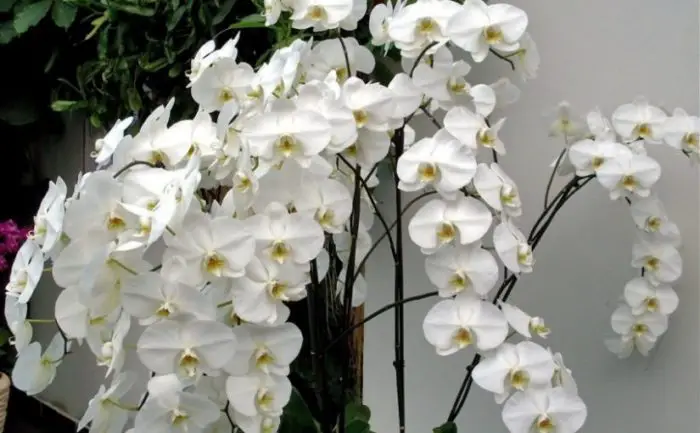
Features of white orchid flower plant
The structure of the plant is not too different from other Phalaenopsis species. Depending on the type, the sizes can reach up to 1 meter or be limited to 30-40 cm. The main feature is the snow-white color of the petals during flowering. This type is great for keeping in an apartment where there are allergy sufferers. Unlike other species, the White Orchid does not have an obsessive odor.
The main features of the exotic beauty:
- size from 30 cm to 1 m;
- flower color – white;
- smell – absent.
Readout 14 colored orchids.
white orchid flower meaning
Translated from Latin, the name White Orchid sounds like “descended from God.” A variety of orchids belonging to the Phalaenopsis varieties is translated as “butterfly”. This name was given to the flower by the famous botanist Blume. It is due to the unusual shape of the peduncle, similar to moths frozen on the stem.
The orchid has always been considered a symbol of wisdom, aristocracy and exalted feelings. As with the rose, the meaning of the flower changes with the color of the petals. Orchids with rich variegated petals represent pure passion, while gentle muted tones symbolize home comfort and warmth.
White Orchid has several meanings:
- pure love;
- harmony;
- the beauty.
Reference! Different countries have their own legends, which determine the meaning of the white orchid.
white orchid Breeding history
The first attempts to breed Falnopsis in the European climate were made back in 1510. The Spanish conquistadors, fascinated by the beauty of this unusual plant, made the first attempts to transport it to Europe. However, all brought copies perished due to inappropriate weather conditions and inept care.
Cultivation in a European climate was possible only 200 years ago. The British were the first to achieve success. They managed to determine the correct care and achieve a full bloom of the orchid. The Chinese took over the baton after them, starting to actively cultivate the culture. Later, the unusual flower spread throughout the world.
Breeders have bred several varieties, the cultivation of which in an apartment is not difficult. These types include:
- Ravel;
- Ravenna;
- Red Dion;
- Pulsation.
8 white orchid flower varieties
Today there are thousands of varieties of orchids. Some have emerged as a result of natural selection, others have been artificially bred. Each species bred has its own unique qualities.
Phalaenopsis are distinguished by the following characteristics:
- time and duration of flowering;
- color of petals;
- form;
- the size of the plant.
The popularity of the exotic culture has increased significantly due to the variety of varieties. Previously, only experienced growers were taken for cultivation and breeding, since the plant required special care and often died in inappropriate conditions. Now many unpretentious varieties have been bred that even an inexperienced beginner can grow.
Royal Phalaenopsis
The variety was bred artificially and appeared not so long ago. The main feature of the plant is its unusually large peduncles. His ancestors are distributed throughout Southeast Asia. There they were named “Queen of the Tropics”.
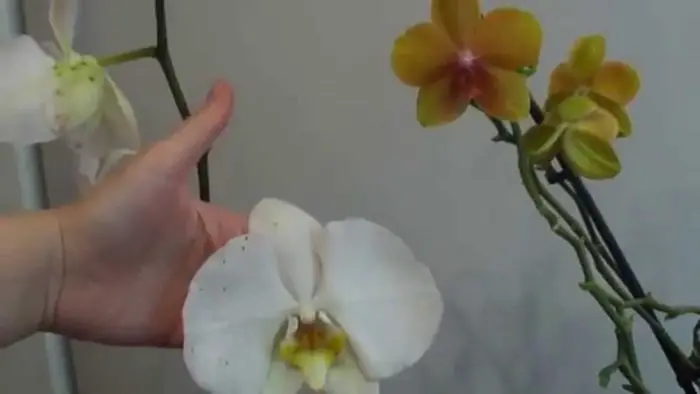
Large and unusually beautiful flowers have a light, unobtrusive aroma. This also contributes to the continued increase in the popularity of the variety among flower growers. Due to their unusual size, the cost of the species is an order of magnitude higher than that of other varieties.
Key Features:
- large boles;
- long peduncle;
- medium-sized leaves;
- big flowers.
Check out Yellow Orchid Flower.
White Vanda orchid
Wild varieties are found in China, India, Australia, Asia, and South America. Many different hybrids have been created for growing in an apartment:
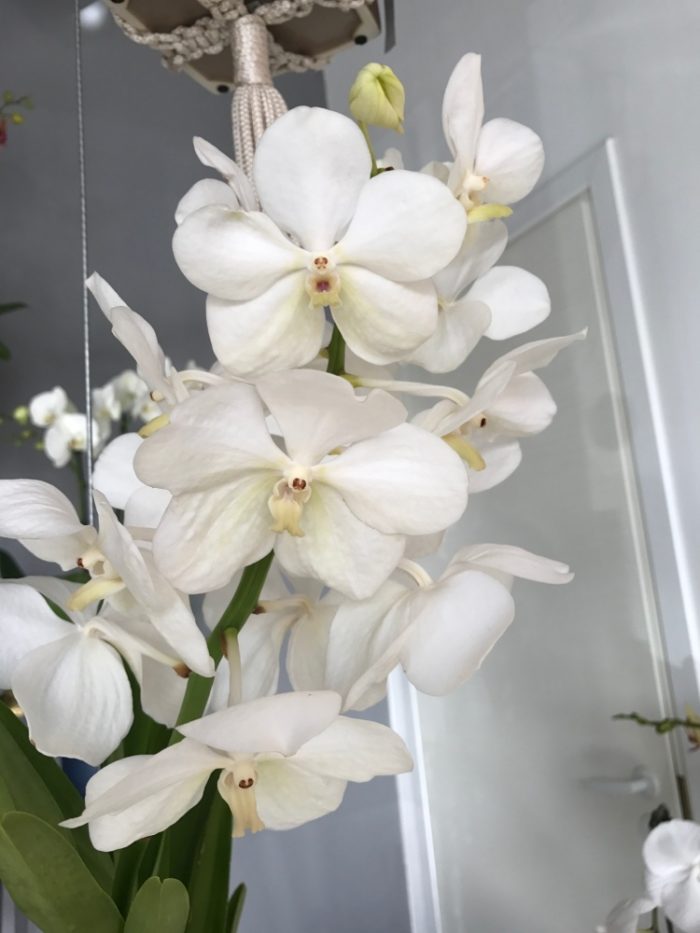
- Ascendas;
- Vanda x Ascocentrum;
- Aerides x Ascocentrum x Phalaenopsis x Vanda.
The flowering time is 1-2 months, the flowers have a pleasant light aroma. Wanda is a slow growing variety, which increases its purchase value. Growing plants of this type requires more time, effort and resources.
White Cattleya orchid
This variety attracts with its unusual, incredibly attractive flower shape, which has a velvety surface and corrugated edges. During the flowering period, the plant emits a delicate delicate aroma.

Classic Cattleya has white petals with a pronounced yellow center. The lip is strongly expressed, the petals are terry, of a complex shape.
Reference! The main feature of the species is the ability to grow independently in width.
Description:
- the stem is thick, fleshy with a supply of water inside;
- leaves are long, narrow, leathery;
- leaf color – dark green;
- flowers of complex shape with a corrugated edge.
You may also like Types of yellow orchids.
Phalaenopsis butterfly orchid
This species is distinguished by long flowering, which, with good care and favorable conditions, can last up to 8 months a year. The name of the variety prompts the idea of its second feature. Phalaenopsis flowers have three sepals and three petals. This feature gives them the shape of a butterfly.
During the flowering period, 5-7 flowers are formed. With age, branched peduncles appear with several awakened buds. This gives the plant a special decorative effect and attractiveness.

Description:
- the stem is missing;
- long peduncle;
- dense leaves;
- multi-flowered brushes.
White heron orchid
Plants of this variety are difficult to confuse with others. The unusual shape invariably attracts florists.
The main features are:
- flowers that resemble a bird in flight;
- narrow oblong leaves of small size;
- roots in the form of tubers.
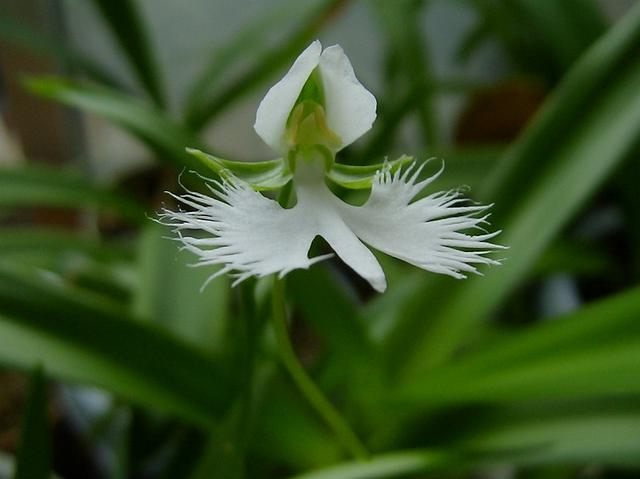
During the dormant period, the plant completely discards the leaves and stems. This variety belongs to protected ones, since despite attempts at mass breeding, it continues to stubbornly disappear. The homeland of the Egret is Japan, but over time it began to be grown in the Far East, Africa and South America.
Many gardeners are trying to acquire this variety for themselves. Due to the excessive whimsicality, its breeding is associated with great difficulties and requires a lot of labor when growing.
White Dendrobium orchid
This is one of the most unpretentious and therefore popular types. There are more than 1600 different varieties, new hybrids appear every year. Plant sizes can range from a few centimeters to 1 meter.
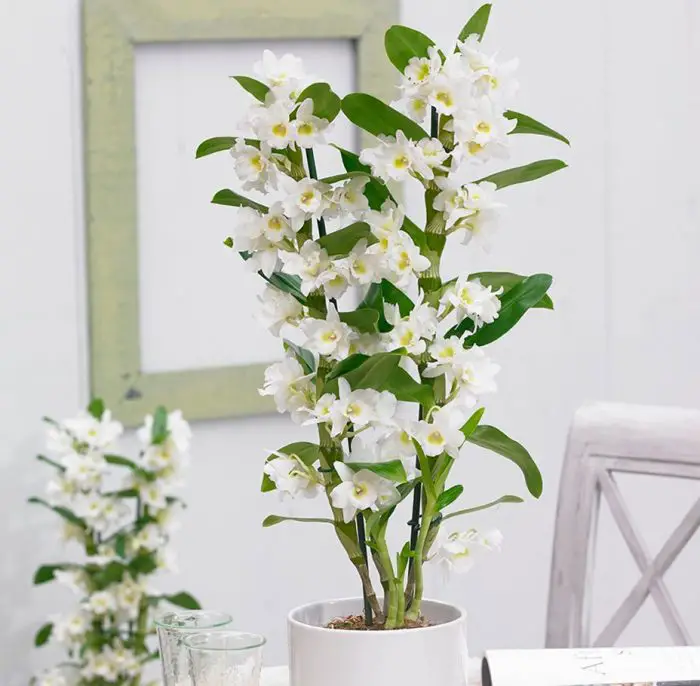
Description:
- an elongated lanceolate leaf;
- roots are dense, with a waxy bloom;
- the bulbs form a kind of trunk.
Reference! The main feature of Dendrobium is the need to use props. The plant is one of the heaviest among orchids and can break under its own weight.
Read it out Maxillaria Orchid.
White Multiflora
This species belongs to compact plants. The name means “multi-flowered”. Its main feature is the formation of numerous branches with flowers. During the flowering period, it is imperative to equip the stems with supports. Peduncles are very flexible, under the weight of the buds, they can slope down and break.

Reference! One plant can form up to 50 flowers.
Main characteristics:
- height – up to 50 cm;
- leaves are oval, fleshy;
- in the outlet 4-8 sheets;
- during flowering forms 2 to 6 arrows;
- flowers are small, from 3 to 6 cm.
Phalaenopsis White Purple Spotted
Orchids of a huge number of varieties can have such an unusual attractive color. Most often, purple spots and veins on a white background are found among the Wanda, Dendrobium, Cattleya species.
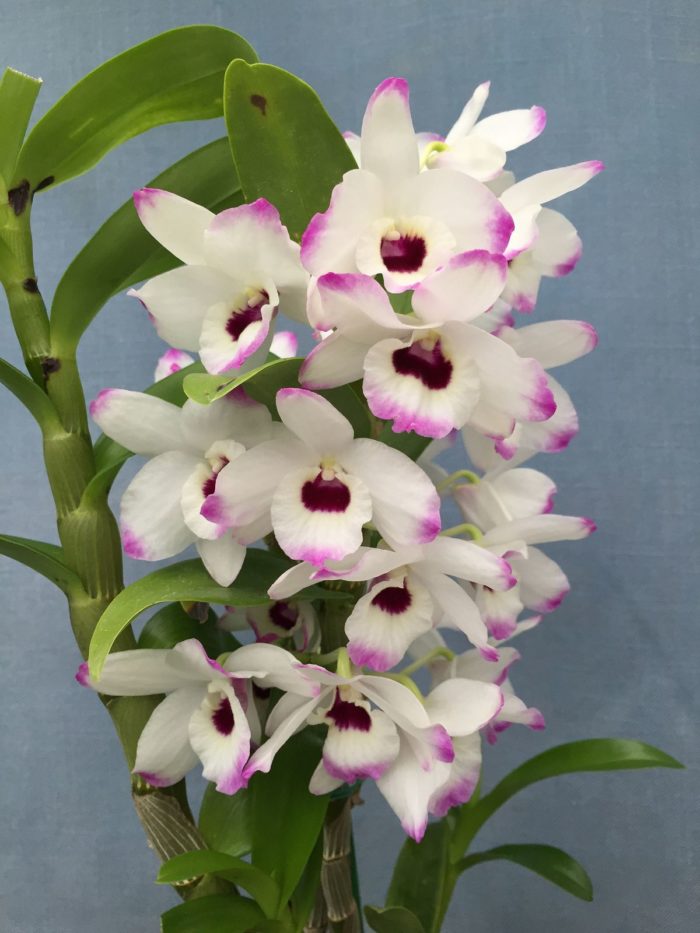
Orchids with exotic colors can be classified according to the following characteristics:
- small round spots are located over the entire surface of the petals;
- purple blotches are collected at the edges;
- only the middle is painted purple;
- spots of different sizes are located chaotically on the petals and core.
Reference! The intensity, shade, location, and size of the spots may vary depending on the variety and conditions.
See also Black Orchids Varieties.
white orchid flower care
There are varieties that are not particularly whimsical. However, in order to obtain a strong, healthy plant that can bloom regularly, it is necessary to provide suitable housing conditions and proper care. More exotic varieties will take a lot of effort. Sometimes, when growing a particularly sensitive variety, novice flower growers fail to achieve flowering.
To keep an orchid inadequate conditions, it is necessary to provide:
- correct watering regime;
- suitable soil and pot;
- the optimal amount of light;
- regular feeding.
Transplant and Potting
When buying a new plant, there is no need for an immediate transplant. This can only harm his condition. A new orchid should be inspected for diseases and pests. Then quarantine for adaptation in a place remote from the rest of the plants. After two to three weeks, the culture can be transplanted into a new pot and placed in a permanent place.
The planting process itself does not differ from that for other indoor plants. The main feature is the selection of the correct soil. The soil for orchids should be air permeable. It is best to use a store-bought substrate. Such mixtures are specially created, taking into account all the features of the species.
When making it yourself, it must be borne in mind that the soil for an orchid consists of the following components:
- expanded clay, pieces of foam or other materials used as drainage;
- sphagnum moss (you can take whole or shredded);
- pieces of pine bark;
- crushed charcoal.
white orchid flower Home care
When growing at home, it is important to follow the watering rules. During the period of active growth, the exotic needs a lot of moisture.
Pre-prepared water is used for irrigation:
- thawed;
- rain;
- defended;
- boiled.
Reference! Water should be with minimum salt content.
During the dormant period, the plant does not need excess moisture. At such a time, it tolerates an overdried substrate better than excessive watering.
Phalaenopsis grows well in places with diffused sunlight. Daylight hours should be 12 hours. In winter, it is better to use additional lighting. Do not place the pot where direct sunlight can hit the leaves. This leads to burns.
The optimum temperature in winter is 20-23 degrees. In summer, the plant feels great at temperatures from +15 to 30 ° C.
Check out a guide on Do Orchids Have Pollen Allergy?
Propagating white orchid flower
Orchid propagation requires certain skills from the grower. Use the following methods:
- vegetation;
- bends;
- kids.
The easiest way to get a new flower is if children have appeared near the old orchid. Small shoots can be simply planted in a separate container. For offsets, cylindrical and thickened shoots are used. They are treated with root-forming preparations and rooted in greenhouses.
With vegetative propagation, the rhizome is cut into several parts, leaving two or three bulbs on each. The sections are treated with charcoal and the resulting fragments are planted in separate containers.
Transplanting a plant does not require special skills. The procedure is no different from transplanting other flowers.
white orchid Pests and diseases
Orchids can infect various diseases and pests. The presence of the latter is easy to determine when examining a flower:
- scale – looks like small growths, the leaves are covered with a sticky substance;
- thrips – create a silvery film and numerous dark dots on the leaves;
- aphids – small greenish insects are visible on the back of the leaf.
Orchids are also often affected by diseases. The most common are:
- powdery mildew;
- spotting;
- sooty mushroom.
